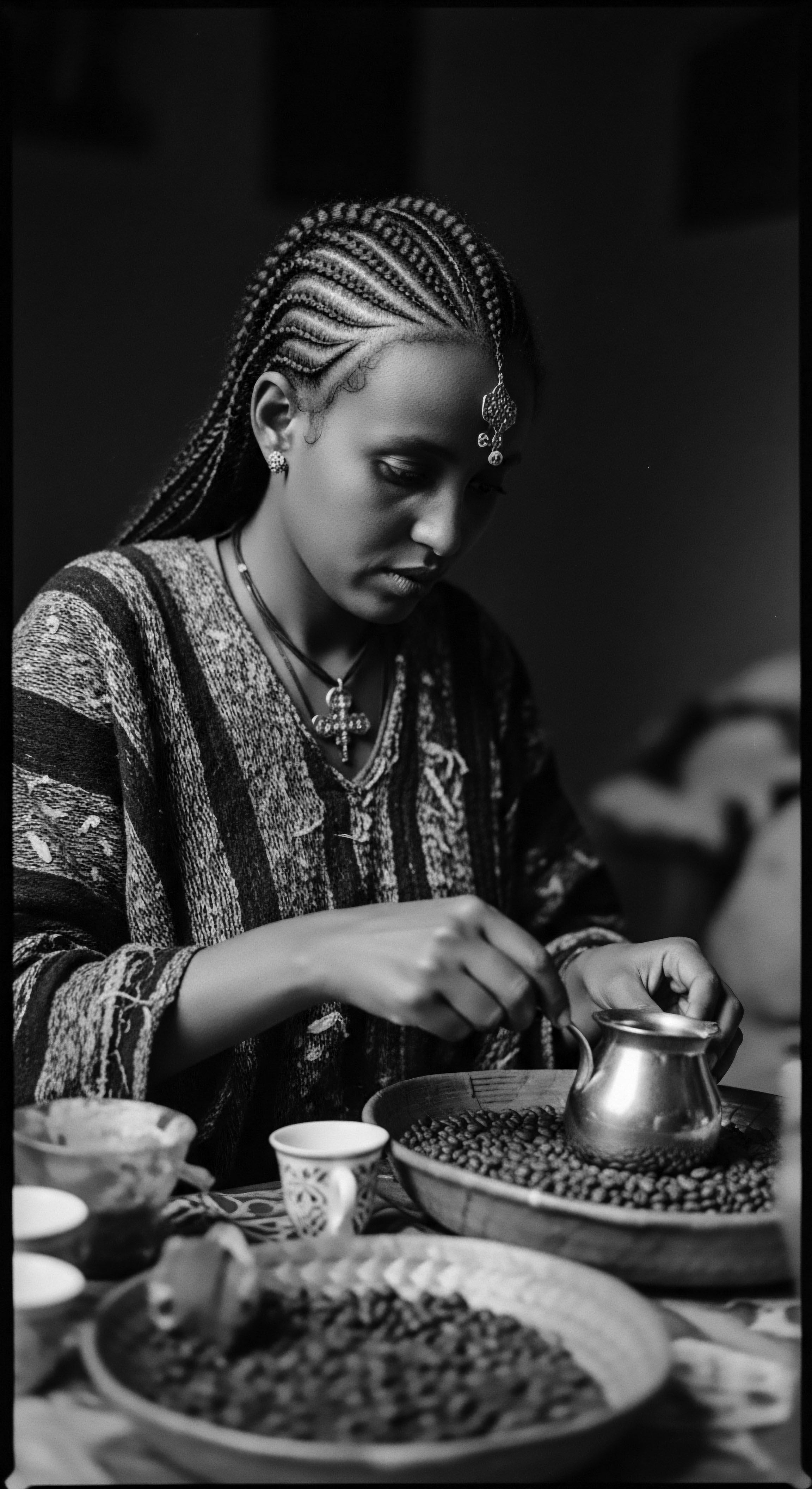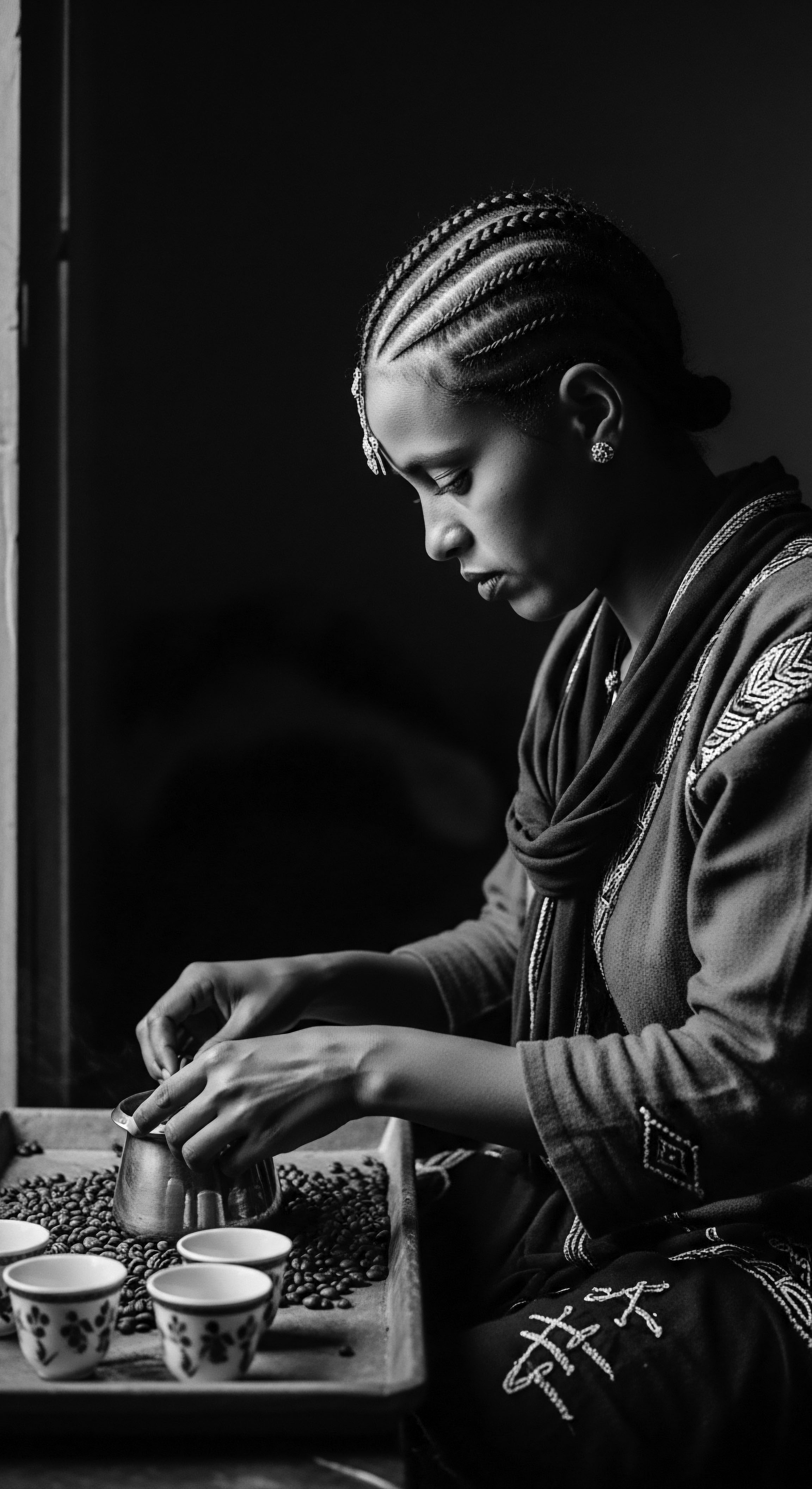
Roots
The coil, a marvel of biological artistry, carries within its very structure the whispers of countless generations. For those whose ancestry traces through the vibrant tapestries of Africa and the diaspora, hair is not merely a biological appendage; it is a living chronicle, a palpable connection to enduring legacies. It holds stories of resilience, of cultural expression, and of ancestral wisdom passed down through touch and ritual.
Our discussion today about Rhassoul clay, a gift from the earth, and its interaction with textured coils, invites us into this profound narrative. It beckons us to consider how ancient practices, rooted in a deep understanding of natural elements, continue to guide our contemporary journey toward hair wellness and self-acceptance.

The Genesis of Coils ❉ An Elemental Heritage
The unique curvature of textured hair, from gentle waves to tightly wound coils, stems from the elliptical or flat shape of its follicle, unlike the round follicles that produce straight strands. This distinctive geometry means that the natural oils, or sebum, produced by the scalp find a more arduous path traveling down the length of each strand, often leaving the ends feeling thirsty. This inherent characteristic has, through generations, necessitated specific approaches to care—methods centered on preserving moisture and minimizing manipulation.
Our forebears, attuned to the rhythms of nature and the needs of their bodies, intuited these principles long before modern science could render them into diagrams and chemical formulas. Their wisdom, born of observation and tradition, laid the groundwork for the holistic hair care practices that echo still in our homes.
Textured hair, with its unique follicular shape, naturally seeks moisture, a need long understood and addressed by ancestral care practices.

Clay’s Ancient Whisper ❉ Ghassoul’s Provenance
From the sun-drenched, rugged peaks of the Atlas Mountains in Morocco, a singular earth has been quarried for centuries, known as Rhassoul clay, or Ghassoul. Its name itself, derived from the Arabic word ‘rhassala,’ means “to wash,” speaking directly to its primary, age-old purpose. This remarkable clay has been a cornerstone of traditional beauty and purification rituals for the Amazigh people and communities across North Africa, its use tracing back to antiquity. Ancient Egyptians, Romans, and Greeks reportedly recognized its benefits.
Its journey from the earth to the communal spaces of the hammam, or public bath, illustrates a profound connection between natural resources, personal care, and shared experience. In these sanctuaries, Rhassoul clay was not merely a cosmetic item; it was a ritual element, a tangible link to heritage. Families often possessed their own methods for preparing the raw clay stones, grinding and purifying them, sometimes with botanical infusions of orange blossom, lavender, myrtle, and chamomile.
This ancestral wisdom ensured the clay was refined for optimal use, a practice passed from mother to daughter, preserving a chain of knowledge. The use of clays for cosmetic ends, including cleansing the skin and hair, is a deeply rooted, long-standing practice throughout Africa, involving various shades of clays combined with plant and animal extracts.

Mineral Earth and Hair’s Thirst ❉ A Molecular Conversation
Rhassoul clay possesses a distinctive mineral composition, rich in silicon (nearly 60%) and magnesium (around 25%), alongside smaller amounts of aluminum, calcium, sodium, and iron. This unique mineral profile, particularly its high silica and magnesium content, distinguishes it from many other clays. It also holds a negative electrical charge.
Impurities and excess oils on the skin and hair often carry a positive charge. The clay’s negative charge attracts these positively charged substances, effectively drawing them out and allowing them to be rinsed away.
For textured coils, this inherent cleansing property is particularly relevant. Unlike harsh modern shampoos that can strip away essential natural oils, leaving hair parched and vulnerable to damage, Rhassoul clay offers a gentle purification. It cleanses without disrupting the hair’s delicate lipid barrier, thereby helping to preserve the hair’s existing moisture. It prepares the hair, leaving it clean and softened, ready to absorb subsequent moisturizing treatments more effectively.
Rhassoul clay’s high silica content has also been noted to aid with detangling and improving manageability for textured hair. This cleansing method aligns with the ancestral understanding of nurturing hair, not simply cleaning it.

Ritual
The application of care for textured coils transcends mere routine; it is a ritual, a conscious act that honors the history and distinct character of these strands. In this spirit, the use of Rhassoul clay extends beyond its scientific properties, becoming a part of a larger, intentional practice that echoes ancestral traditions of self-care and communal well-being. It is within this purposeful interaction that the clay’s true affinity for textured hair reveals itself, not as a direct hydrator, but as a facilitator of genuine moisture.

The Ceremony of Cleanse ❉ Preparing Coils for Renewal
Employing Rhassoul clay on textured coils begins with transformation ❉ the fine reddish-brown powder, a dormant earth, awakens into a smooth, pliable paste when mingled with water or nourishing botanical liquids. This blend can be enriched further with elements like aloe vera juice or honey, which lend additional slip and hydration. The resulting mixture, silken to the touch, is then gently applied, often focusing on the scalp to purify follicles and on the lengths to cleanse and soften. The act of mixing and applying becomes a meditation, a tender connection with the material and its purpose.
The clay’s mild action ensures that while dirt, oil, and product buildup are effectively lifted, the hair’s inherent moisture is respected. This is a profound distinction for coils, which often struggle with retaining moisture due to their structural configuration. The practice leaves the scalp feeling refreshed and clean, without the tight, dry sensation that accompanies overly harsh cleansing agents. The hair strands themselves feel supple, prepared for the conditioning steps that follow.

Traditional Applications and Modern Adaptations ❉ A Continuum of Care
Throughout history, particularly in North African cultures, Rhassoul clay was integral to the hammam ritual, a holistic cleansing experience that spanned body, skin, and hair. This practice symbolized a deep approach to purity and self-reverence. In contemporary textured hair care, the application of Rhassoul clay continues this tradition, though perhaps in a more personalized setting. The principle remains constant ❉ a gentle, yet effective cleanse that respects the hair’s integrity.
| Traditional Practice Used with warm water, often within communal hammam settings, for full-body purification. |
| Contemporary Application Blended with botanical infusions or warm water at home, applied as a pre-shampoo or shampoo alternative. |
| Implication for Textured Hair Heritage The practice honors ancestral rituals of communal cleansing, adapting them for modern personal care. |
| Traditional Practice Applied generously to hair and scalp, followed by rich oils and body massages. |
| Contemporary Application Concentrated on scalp health and hair lengths, preparing strands for leave-in conditioners and styling products. |
| Implication for Textured Hair Heritage The core understanding of preparing hair to receive sustenance carries through generations. |
| Traditional Practice Part of multi-day bridal rituals, signifying purity and beauty for a new chapter. |
| Contemporary Application Integrated into weekly or bi-weekly routines, signifying a conscious choice for natural, gentle care. |
| Implication for Textured Hair Heritage A continuity of the clay's value as a significant element in beauty and well-being. |
| Traditional Practice Rhassoul clay bridges ancient wisdom and modern needs, underscoring its enduring significance in textured hair traditions. |

Dispelling Misconceptions ❉ Clay and Hydration for Textured Hair
The question of whether Rhassoul clay directly moisturizes textured coils often surfaces, given the hair type’s inherent need for hydration. It is important to approach this with clarity. Rhassoul clay, in its fundamental mineral composition, functions as a cleansing and purifying agent. It contains no emollients or humectants that would directly deposit moisture onto the hair shaft in the manner of an oil or conditioner.
Rhassoul clay primarily cleanses without stripping, preparing textured coils to better absorb subsequent moisturizing elements.
Its benefit regarding moisture for textured coils lies in its exceptional ability to cleanse without stripping the hair of its natural oils, which are vital for maintaining elasticity and preventing breakage. Unlike some conventional cleansers that can leave hair feeling rough and depleted, Rhassoul clay leaves the hair feeling clean, soft, and remarkably receptive. This receptiveness allows subsequent moisturizing products, such as conditioners, leave-ins, and natural oils, to penetrate the hair shaft more effectively, thus enhancing the hair’s overall moisture retention. Think of it as preparing the soil for rich growth; the clay clears the way, allowing nutrients to truly take root.

Relay
The journey of Rhassoul clay from the earth to our textured coils forms a narrative that transcends simple product efficacy. It is a story of relay, of ancestral knowledge passed through time, of the very ground beneath our feet speaking to the needs of our hair and our spirit. This transmission of wisdom, often through quiet, familial practices, has ensured the survival and continued relevance of ingredients like Rhassoul clay in the broader scope of Black and mixed-race hair heritage.

Beyond Cleansing ❉ Clay as a Cultural Anchor for Identity
For communities whose history is marked by the suppression of cultural identity, hair has often served as a potent symbol of defiance, artistry, and continuity. The choice to use natural ingredients, particularly those with deep historical roots, is a conscious act of reclaiming and honoring heritage. Rhassoul clay, with its ancient origins in North Africa, symbolizes a profound connection to the earth and to an unbroken lineage of self-care. It represents a form of beauty ritual that existed long before the imposition of external beauty standards, practices that were intrinsically tied to personal and communal identity.
The preparation and use of clays in various African societies were not merely functional; they were interwoven with cultural significance, sometimes marking rites of passage, social standing, or even serving protective purposes. This deeper meaning resonates today, as individuals seek not just products that perform, but ingredients that carry a story, that affirm a connection to a rich, often marginalized, history.
- Cultural Cleansing ❉ Beyond physical purification, Rhassoul clay in traditional contexts held symbolic weight, representing cleanliness and purity.
- Ancestral Connection ❉ Using ancient earth materials like Rhassoul clay honors the ingenuity and wisdom of previous generations.
- Self-Affirmation ❉ Choosing heritage-rich ingredients contributes to a sense of identity and pride in one’s coils and their history.

The Science of Soil’s Embrace ❉ Validating Ancestral Wisdom
Modern scientific inquiry, with its precise measurements and molecular insights, often arrives at conclusions that align remarkably with long-standing ancestral practices. Rhassoul clay offers a compelling example. Its rich mineral composition – specifically high concentrations of magnesium, silica, and calcium – is now recognized for its benefits to both skin and hair.
Studies on clays in general highlight their ability to absorb toxins and impurities from the skin due to their high absorption properties and negative charge. This confirms the intuitive understanding that generations had regarding its purifying abilities.
While direct clinical trials on Rhassoul clay’s moisturizing effects on hair are not extensively documented in specific large-scale studies, the scientific understanding of its cleansing action provides a powerful indirect validation. Rhassoul clay’s capacity to cleanse the scalp and hair without stripping away natural oils means it helps maintain the scalp’s balance and the hair’s inherent hydration. This is particularly valuable for textured hair, which is prone to dryness due to the uneven distribution of sebum along its coiled structure. By preserving the scalp’s health and allowing natural oils to persist, the hair is in a prime state to absorb and retain moisture from subsequent conditioning treatments.
It prepares the strands for true hydration, rather than directly supplying it. One paper notes that Rhassoul clay is “known for its strong detoxifying, oil-absorbing, and purifying properties, effectively cleansing impurities from the skin and scalp while maintaining moisture balance.”
The presence of minerals like silica can also contribute to the hair’s sheen and manageability. This scientific lens, therefore, does not diminish the ancestral practices but rather provides a contemporary vocabulary to articulate their deep efficacy. The wisdom of the elders finds its echoes in the laboratory, proving that the earth held secrets our ancestors intuitively understood.

Intergenerational Threads ❉ Passing on the Legacy of Earth’s Goodness
The continuity of hair care traditions, especially those involving natural elements like Rhassoul clay, relies on the intergenerational transfer of knowledge. For many Black and mixed-race families, hair care sessions are not merely about styling; they are moments of bonding, of storytelling, of cultural instruction. In these moments, recipes are shared, techniques demonstrated, and the significance of each ingredient, each gesture, is imbued with meaning.
The shift towards embracing natural hair and traditional practices is a testament to this enduring legacy. As more individuals seek alternatives to chemically aggressive products, they turn to the wisdom of their ancestors, discovering ingredients like Rhassoul clay that offer gentle, effective care. This return to roots is not a regression; it is a profound forward movement, one that honors the past while building a healthier, more culturally resonant future for textured hair care. It reinforces the idea that true beauty care is always holistic, connecting body, spirit, and heritage.

Reflection
The journey through Rhassoul clay’s potential to nourish textured coils reveals a story far richer than simple scientific inquiry. It speaks to the enduring legacy of textured hair, a heritage steeped in wisdom, resilience, and a profound connection to the natural world. From the sun-baked earth of the Atlas Mountains, Rhassoul clay emerges not merely as a cleansing agent, but as a living symbol of ancestral insight. Its gentle, purifying action, a process that prepares coils to receive and hold moisture rather than directly imparting it, mirrors a fundamental principle of nurturing that transcends generations.
Our exploration has shown how the very structure of textured hair necessitates a careful, respectful approach to care, a truth intuited by those who came before us. The integration of Rhassoul clay into care practices today is a conscious choice, a quiet act of defiance against narratives that once sought to diminish our hair’s inherent beauty. It is a continuation of a ceremony, a tender thread connecting the present to a vibrant past, allowing each strand to whisper its unique history. Roothea’s vision, of hair as a living archive, finds its embodiment in these practices, where the earth’s bounty and ancestral knowledge combine to allow textured coils to truly flourish, unbound and radiant, in their full, glorious heritage.

References
- Helenatur. (2020). Rhassoul clay.
- Matike, D.M.E. Ekosse, G.I. & Ngole, V.M. (2010). Indigenous knowledge applied to the use of clays for cosmetic purposes in Africa ❉ an overview. Sabinet African Journals, 1(2), 138-145.
- Obscure Histories. (2024). Ancient Gems ❉ A Historical Survey of African Beauty Techniques.
- Croda Beauty. (2025). Advancing the future of textured hair solutions.
- MÖSS. (2025). What defines hair texture?
- Ghassoul Clay. (2019). Origin & History Of This Amazing Wonder!
- Ibomvu ❉ The Holy Grail clay used as a beauty treatment by the people of Southern Africa. (2024).
- Neelkanth Finechem LLP. (n.d.). Rhassoul Clay.
- Rosebrook, J. (2022). Textured Hair 101 ❉ What it Needs, How to Care for it, and More.
- Lotioncrafter. (n.d.). Rhassoul Clay | Moroccan Clay Powder for Hair & Skincare.
- Noma Sana. (2025). The Science Behind Textured Hair ❉ Why It Needs Different Care.
- CurlMix. (2021). How Black Hair Plays a Role in Black History.
- Minimalist Beauty. (n.d.). Rhassoul Clay Versus Bentonite Clay.
- Everything You Need to Know About Rhassoul Clay ❉ For Hair and Skin Detoxification! (2019).
- US9107839B1 – Hair care composition. (2015). Google Patents.
- A Shocking Ingredient You Need for Your Hair ❉ The Surprising Benefits of Clays in Hair Care. (2025).
- INDIGENOUS KNOWLEDGE USE OF CLAY WITHIN AN AFRICAN CONTEXT ❉ POSSIBLE DOCUMENTATION OF ENTIRE CLAY PROPERTIES? (2018). Unisa Press Journals.
- Rhassoul ❉ a ritual for hair and skin care to purify and relax body and soul. (2024).
- ResearchGate. (2024). indigenous knowledge applied to the use of clays for cosmetic purposes in africa ❉ an overview.
- Botanical Voyage. (2024). Africa’s Timeless Beauty Secrets.
- Tara – Nature’s Formula. (n.d.). Ghassoul Clay.
- Healthline. (2019). Rhassoul Clay Benefits and Uses for Hair and Skin, and Precautions.
- Salford Students’ Union. (2024). The Remarkable History Behind Black Hairstyles.
- Notes From the Frontier. (2019). Native Hair Traditions.
